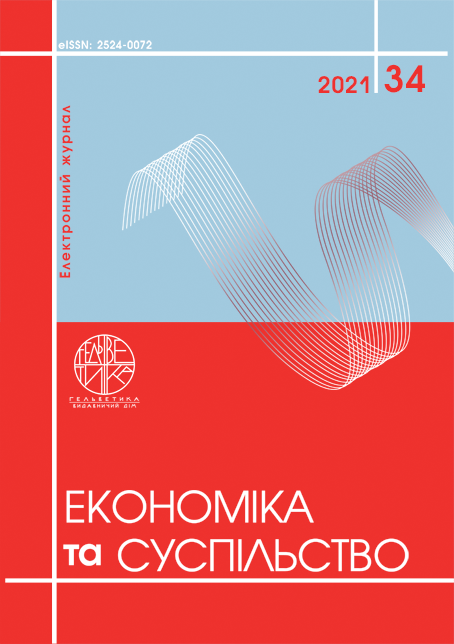MODERN INFORMATION TECHNOLOGIES AS STRATEGIC RESOURCES OF EXCHANGE ACTIVITY IN THE CONDITIONS OF DIGITALIZATION
Abstract
The fundamental principles of a Digital economy or Internet economy or web economics, which are closely intertwined with the traditional economy, have been researched. The key influence of modern information technologies on exchange activity in the conditions of digitalization has been researched. E-business strategies that define all business processes have been researched. The electronic trading system of the commodity exchange has been characterized. Peculiarities of formation and functioning of electronic trade and electronic exchange activity are determined. The definition of the concept of "stock market" has been analysed. A conceptual model of the logistics system of exchange activity of business entities has been proposed. It has some differences from existing ones and includes: 1) the chain seller − exchange − the buyer, in which the seller wants to get the highest price, in turn, the buyer − the lowest, and the task of the exchange is to regulate prices for all of sides; 2) мanagement and material flow and related flows optimization: information, financial, service (service flows), etc; 3) еxchange process, which consists of three consecutive operations: preparation of exchange trading; their holding (meetings, sessions); registration and execution of transactions on the stock exchange; 4) аppropriate infrastructure (complex of exchanges, brokerage offices, warehouses and other material elements of the market), which ensures the implementation of exchange transactions, accounting for their results, insurance transactions and compliance with established rules. The purpose of the logistics system of logistics exchange activities of economic entities, which are such systems in the optimal organization of the movement of structural logistics flows with minimal costs in space and time. The properties of the logistics system of exchange activity of business entities have been formulated, namely: manageability; purposefulness; the presence of a governing body; variability of behavior; availability of information communications (both in the system itself and between the logistics system and the external environment); ability to interact with the external environment. The definition of material flow has been formulated. The nature of the formation of material flow is determined, which is manifested in the optimal choice of the lot and the type of exchange transaction.
References
Fatos UKAJ, Vehbi RAMAJ, Ramiz LIVOREKA. Journal of Distribution Science. 2020. No 18−8. Рр. 103−112.
Begovic S.E-business Trainer's Manual. Project Ebusiness Development. 2016. 273 р.
Цифровізація економіки України, трансформаційний потенціал: монографія / В.П. Вишневський, О.М. Гаркуненко, С.І. Князєв, Д.В. Липницький, В.Д. Чекіна; за заг. ред. В.П. Вишневського та С.І. Князєва; НАН України, Інститут економіки промисловості. Київ : Академперіодика, 2020. 188 с.
Rios R., Lopez J. B. L. & Veiga J. G. The fifth global Kondratiev: low economic performance, instability and monopolization in the digital age. Marketing and Management of Innovations. 2018. No 2. Рр. 270−291.
Куцик П.О., Ковтун О.І., Башнянин Г.І. Глобальна економіка: принципи оновлення, функціонування, регулювання та розвитку : монографія. Львів : Видавництво ЛКА, 2015. 594 с.
Чирак І.М. Нова економіка : навч. посіб. Тернопіль : ТНЕУ, 2016. 236 с.
Цикли Кондратьєва. Матеріал з Вікіпедії − вільної енциклопедії. URL: https://uk.wikipedia.org/wiki/ (дата звернення: 28.12.2021).
Інтернет-економіка / Матеріал з Вікіпедії − вільної енциклопедії. URL: https://uk.wikipedia.org/wiki/ (дата звернення: 28.12.2021).
Tapscott Don. The digital economy: promise and peril in the age of networked intelligence. New York: McGraw-Hill. 1997.
Mesenbourg T.L. Measuring the Digital Economy. U.S. Bureau of the Census. 2001. URL: https://www.census.gov/content/dam/Census/library/working-papers/2001/econ/umdigital.pdf (дата звернення: 28.12.2021).
Смарт-промисловість: напрями становлення, проблеми і рішення: монографія / В.П. Вишневський, О.В. Вієцька, О.А. Вієцький та ін.; за ред. В.П. Вишневського; НАН України, Ін-т економіки пром-сті. Київ, 2019. 464 с.
Про товарні біржі: Закон України / від 10 грудня 1991 р. № 1956-XII / Верховна Рада України. Відомості Верховної Ради України. 1992. № 10. Ст.139. URL: https://zakon.rada.gov.ua (дата звернення: 28.12.2021).
Підгорний А.З., Самотоєнкова О.В. Методологія статистичного дослідження біржової діяльності : навчальний посібник. Одеса : ФОП Гуляєва В.М., 2018. 170 с.
Fatos UKAJ, Vehbi RAMAJ, Ramiz LIVOREKA (2020). Journal of Distribution Science, no 18−8, pp. 103−112.
Begovic S.E-business Trainer's Manual (2016). Project Ebusiness Development. 273 р.
Vyshnevsʹkyy V.P., Harkunenko O.M., Knyazyev S.I., Lypnytsʹkyy D.V., Chekina V.D. (2020) Tsyfrovizatsiya ekonomiky Ukrayiny, transformatsiynyy potentsial [Digitization of Ukraine's economy, transformation potential]. monohrafiya [a monograph]. Kyiv : Akademperiodyka, 188 р. (in Ukrainian)
Rios R., Lopez J. B. L. & Veiga, J. G. (2018). The fifth global Kondratiev: low economic performance, instability and monopolization in the digital age. Marketing and Management of Innovations, no 2, рр. 270−291.
Kutsyk P.O., Kovtun O.I., Bashnyanyn H.I. (2015) Hlobalʹna ekonomika: pryntsypy onovlennya, funktsionuvannya, rehulyuvannya ta rozvytku [Global economy: principles of renewal, functioning, regulation and development]. monohrafiya [a monograph]. Lʹviv : Vydavnytstvo LKA. 594 р. (in Ukrainian)
Chyrak I.M. (2016) Nova ekonomika [The new economy]. Ternopil: TNEU. 236 p. (in Ukrainian)
Tsykly Kondratʹyeva [Kondratiev cycles]. Available at: https://uk.wikipedia.org/wiki/ (accessed 28 December 2021).
Internet-ekonomika [Internet economy]. Available at: https://uk.wikipedia.org/wiki/ (accessed 28 December 2021).
Tapscott Don (1997) The digital economy: promise and peril in the age of networked intelligence. New York: McGraw-Hill.
Mesenbourg T.L. (2001) Measuring the Digital Economy. U.S. Bureau of the Census. Available at: https://www.census.gov/content/dam/Census/library/working-papers/2001/econ/umdigital.pdf (accessed 28 December 2021).
Vyshnevsʹkyy V.P., Viyetsʹka O.V., Viyetsʹkyy O.A. (2019) Smart-promyslovistʹ: napryamy stanovlennya, problemy i rishennya [Smart industry: directions of formation, problems and solutions]. monohrafiya [a monograph]. Kyiv: NAN Ukrayiny, In-t ekonomiky prom-sti, 464 р. (in Ukrainian)
The Verkhovna Rada of Ukraine (1991), Law of Ukraine "About commodity exchanges", available at: https://zakon.rada.gov.ua (accessed 28 December 2021).
Pidhornyy A.Z., Samotoyenkova O.V. (2018) Metodolohiya statystychnoho doslidzhennya birzhovoyi diyalʹnosti [Pidgorny AZ, Samotoenkova OV Methodology of statistical research of exchange activity]. Odesa: FOP Hulyayeva V.M., 170 p. (in Ukrainian)


